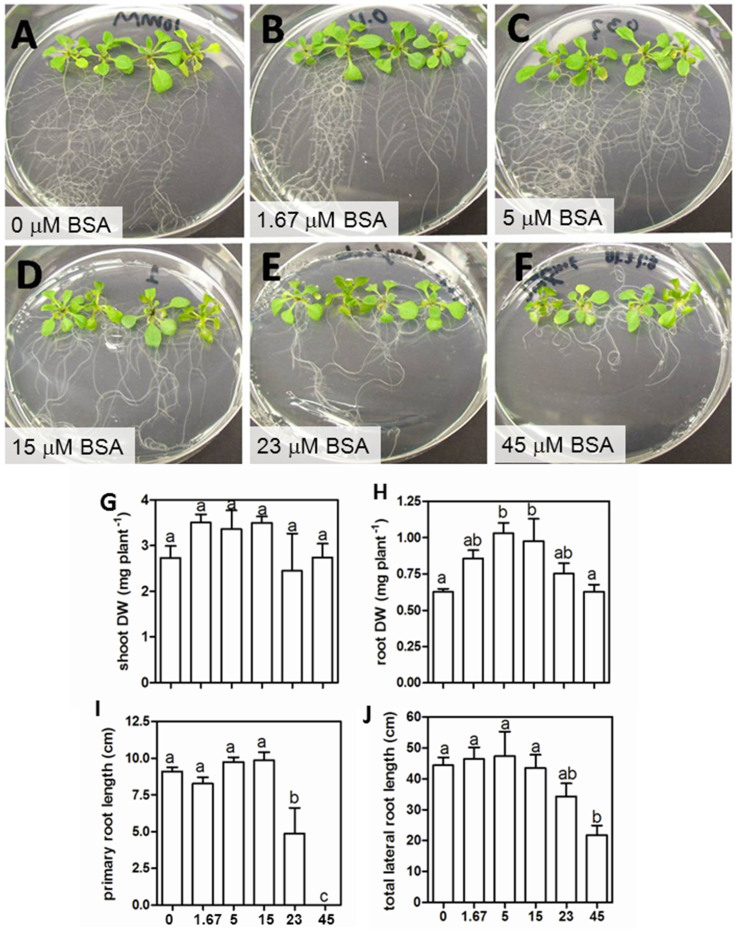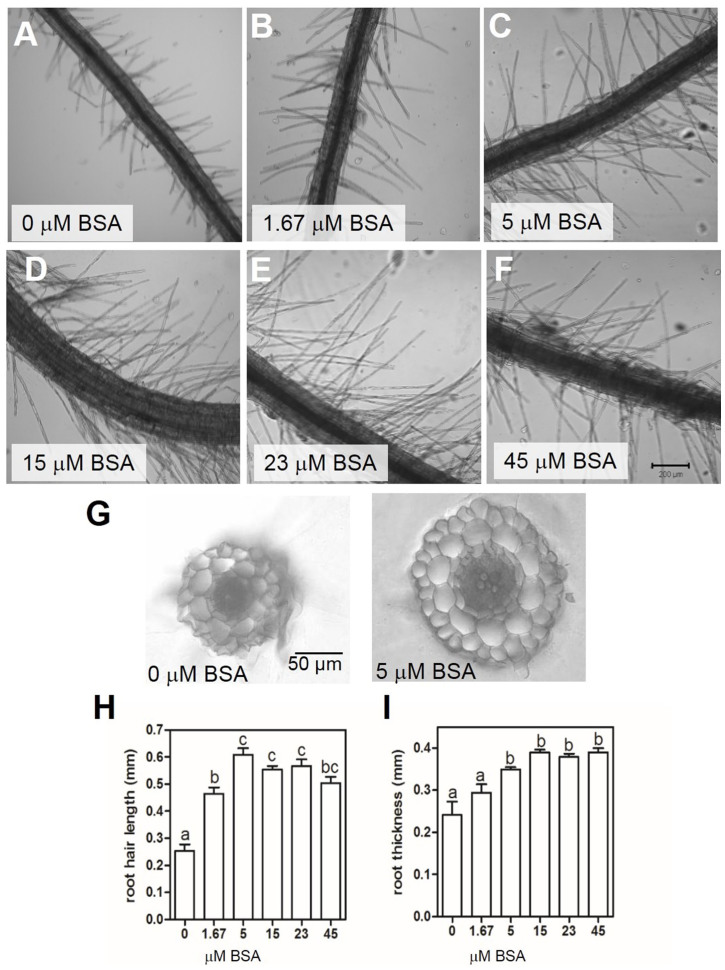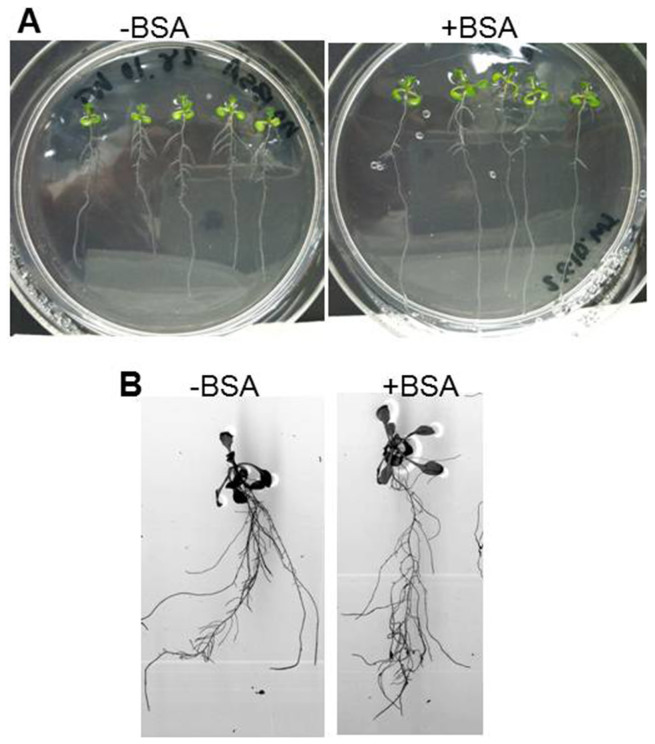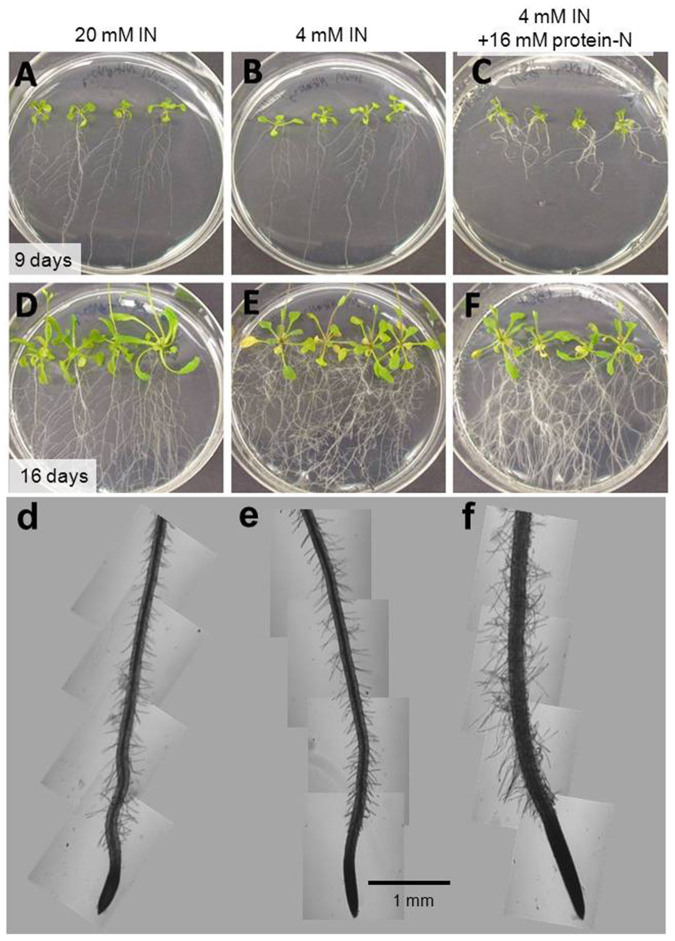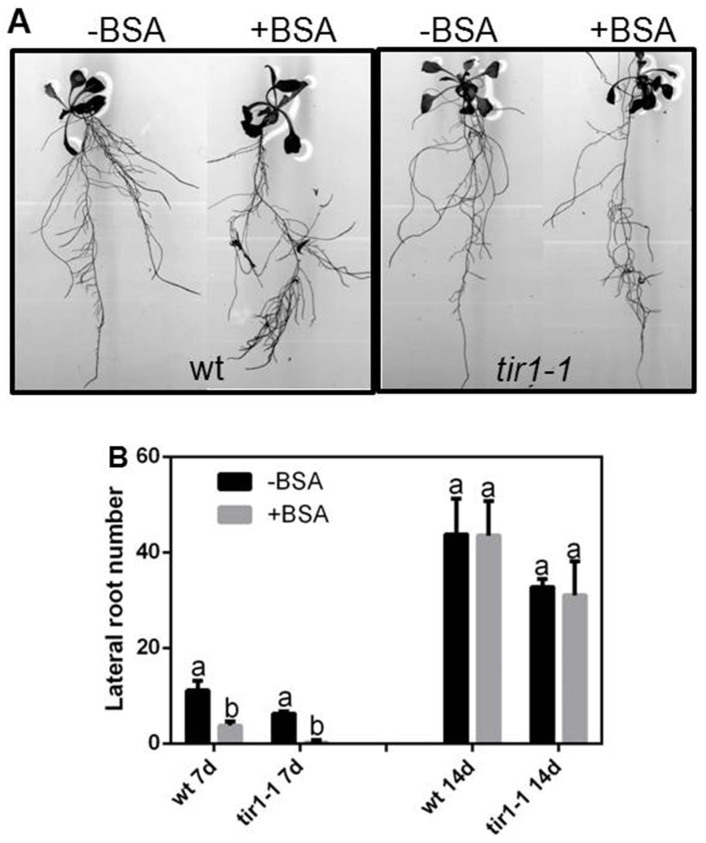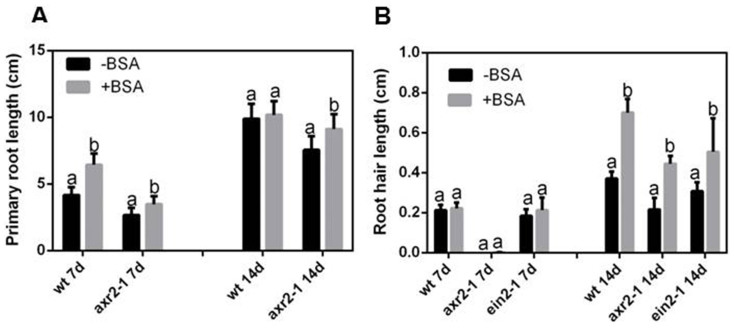Abstract
Growth, morphogenesis and function of roots are influenced by the concentration and form of nutrients present in soils, including low molecular mass inorganic N (IN, ammonium, nitrate) and organic N (ON, e.g. amino acids). Proteins, ON of high molecular mass, are prevalent in soils but their possible effects on roots have received little attention. Here, we investigated how externally supplied protein of a size typical of soluble soil proteins influences root development of axenically grown Arabidopsis. Addition of low to intermediate concentrations of protein (bovine serum albumen, BSA) to IN-replete growth medium increased root dry weight, root length and thickness, and root hair length. Supply of higher BSA concentrations inhibited root development. These effects were independent of total N concentrations in the growth medium. The possible involvement of phytohormones was investigated using Arabidopsis with defective auxin (tir1-1 and axr2-1) and ethylene (ein2-1) responses. That no phenotype was observed suggests a signalling pathway is operating independent of auxin and ethylene responses. This study expands the knowledge on N form-explicit responses to demonstrate that ON of high molecular mass elicits specific responses.
The concentrations and forms of nutrients influence plant growth and performance, including biomass partitioning and root morphology such as length, surface area and root hair characteristics1,2,3. Such plasticity allows plants to optimize their function in different nutritional environments4. For example, the presence and concentration of inorganic nitrogen forms (IN, ammonium, nitrate) affect biomass partitioning, root growth and root morphology5. While ammonium can stimulate lateral root initiation and higher-order lateral root branching, nitrate stimulates lateral root elongation6,7. Plants respond to N deficiency with increased root branching, root and root hair length, and root hair density8, including strongly favouring root growth9. While a low concentration of nitrate stimulated lateral root elongation, higher concentrations inhibited root development10. Overall, the effects of IN on plant growth and function are well documented11.
Less is known about the effects of organic nitrogen forms (ON, amino acids, small peptides, protein) on biomass allocation and root growth, because ON has received less attention as N source and growth regulator. A reason is that the artificially boosted prevalence of IN in fertilized agricultural soil12 has largely replaced the focus on ON that characterized early plant nutrition research in early 20th century. However, soil of natural ecosystems is often dominated by ON and composed of ~35–40% proteinaceous (proteins, peptides, amino acids, amino sugars) and heterocyclic compounds (nucleic acids, pyridines, pyrroles)13,14. The average concentration of free amino acids in soils is ≈23 μM15 and soluble protein is ≈10-fold higher16. Unfertilized, cool-climate cropping soil is dominated by soluble and bound amino acids at concentrations >600 μM17. Amino acids are also prevalent in sub/tropical agricultural soil once the initially high concentrations of fertiliser-derived IN subside18. In temperate agricultural soil, ON compounds of intermediate molecular mass were detected19.
Evidence is accruing that, similar to IN, ON elicits change to root growth and biomass partitioning. Hutchinson and Miller (1911) pioneered research on the effects of ON forms on plant development20. Their cultivation of radish plants in ‘single N source' hydroponic culture set the scene for controlled-system experiments and demonstrated that ON in the form of urea resulted in largest shoots, while acetamide stimulated root length more than any other N source tested. More recently, research has focused on amino acids and small peptides. Responses range from near complete inhibition of root growth in the presence of high concentrations of single amino acids such as glycine, to root elongation, adventitious root formation and increased root/shoot ratio observed with single amino acids such as glutamine, amides, peptides or mixtures of ON compounds21,22,23,24,25,26,27. Plants also access protein, possibly through combined uptake of protein and secretion of proteases28. Supplied as the sole N source, protein (bovine serum albumin, BSA; 66 kDa) increased root growth in axenically cultivated Arabidopsis thaliana and Hakea actites, and doubled the length of Arabidopsis primary roots28. This suggests that, similar to IN and low molecular mass ON, protein elicits responses in roots. Here, we evaluated how protein affects root structure and biomass allocation in dose-response experiments with BSA and IN present in the growth medium. We further tested if observed changes in root structure in response to BSA involved auxin and ethylene signalling pathways.
Results
Addition of BSA to nutrient-replete IN medium triggers morphological responses in roots
Axenic Arabidopsis plants were grown in nutrient-replete medium with IN supplied as ammonium-nitrate (20 mM N) and protein (BSA) concentrations varying from 1.67 to 45 μM (corresponding to 1.2 to 32 mM protein-N, see Table 1, experiment 1). Plants were examined after 14 days of growth. Compared to IN only treatment, plants grown in the presence of IN supplemented with low to medium concentration of BSA (≤5 μM BSA) produced thicker roots with increased biomass and longer root hairs (Figs. 1 and 2). Note that the apparent heterogeneity in root biomass of plates 1B and C are a visual artefact because roots of the two plants on the left are growing at the surface whereas those on the right are growing in agar. Statistical analysis showed that roots of plants in the same plate had similar biomass (Fig. 1H). Noticeably, the increase of root thickness was associated with an increase of the number of cells in the single cortical and endodermal layer from 8 to 10 cells (Fig. 2G). Shoot biomass, primary root and total lateral root length remained unchanged (Fig. 1). At concentrations of BSA ≥ 15 μM, root architecture changed as the standard pattern of lateral roots emerging from a single main root was replaced by a configuration of undifferentiated adventitious roots (Fig. 1D–F). The increase of root thickness and root hair length was maintained (Fig. 2) but root biomass decreased (Fig. 1H).
Table 1. Overview of axenic culture experiments testing the effects of N forms and concentrations on plant growth. Experiment 1 consisted of a concentration series with 1.67 to 45 μM protein (BSA, 66 kDa, 15% N) added to nutrient-replete half-strength MS medium (20 mM IN-N). Experiment 2 provided N as low or replete IN (4 or 20 mM IN-N) or as low IN + protein (4 mM IN + 16.1 mM protein-N).
| mg BSA per ml growth medium | BSA (μM) | BSA-N (mM N) | IN (mM N) | total N (mM N) | total N (mg N perplate) |
|---|---|---|---|---|---|
| Experiment 1 | |||||
| - | - | - | 20 | 20 | 8.4 |
| 0.11 | 1.67 | 1.2 | 20 | 21.2 | 8.9 |
| 0.33 | 5.0 | 3.6 | 20 | 23.6 | 9.9 |
| 1.0 | 15 | 10.7 | 20 | 30.7 | 12.9 |
| 1.5 | 23 | 16.1 | 20 | 36.1 | 15 |
| 3.0 | 45 | 32.1 | 20 | 52.1 | 21.9 |
| Experiment 2 | |||||
| - | - | - | 20 | 20 | 8.4 |
| - | - | - | 4 | 4 | 1.7 |
| 1.5 | 23 | 16.1 | 4 | 20 | 8.4 |
Figure 1. Arabidopsis plants (A–F), shoot (G) and root (H) dry weight, primary root length (I) and lateral root length (J) after 14 days on axenic agar medium containing inorganic N (20 mM N, all treatments) and increasing concentrations of protein (1.67–45 μM protein supplied as BSA).
See Table 1, Experiment 1, for details. Bars of panels (G–J) represent average ± SEM of 3 plates each with 4 Arabidopsis plants.
Figure 2. Root hair and root thickness of Arabidopsis plants grown for 14 days on medium with 20 mM IN-N and increasing concentrations of protein (see Figure 1 and Table 1, experiment 1).
(A–F) Microscope images of root hairs. Size of scale bar is 200 μm. (G) Cross-section of primary roots of 14-days old Arabidopsis grown on 20 mM IN-N without BSA (left panel) or with addition of 5 μM BSA (right panel). (H) Statistical analysis of root hair length and root thickness. Bars of H represent average ± SEM of 10 roots hairs on each of three plants. Bars of I represent average ± SEM of 3 plates each with 4 Arabidopsis plants Small letters indicate statistically significant (P < 0.05) differences between treatments (ANOVA, Neuman–Keuls post hoc test). Similar results were obtained in another independent experiment.
In plants treated with low to medium concentration of BSA (≤5 μM BSA), the timing of lateral root initiation was modified. Within the first week of growth, primary roots were consistently longer, in agreement with a previous study28, whereas the length and number of lateral roots decreased (Fig. 3A). While the growth of the primary roots slowed down during the second week of growth, initiation and development of lateral roots increased, particularly in lower regions of the primary roots, reaching a total root length similar to control plants grown with IN only (Fig. 3B).
Figure 3. BSA affects the root biomass repartition in Arabidopsis.
Plants were grown for 7 d (A) or 14 d (B) on medium containing 20 mM IN-N without BSA or with 5 uM BSA added. (A) While primary root length increased in the early growth phase (7 d), the length and number of lateral roots decreased in response to BSA addition. (B) At later stage of growth (14 d), the length and number of lateral roots of plants grown with BSA increased, particularly in the lower part of the primary root.
The effects of BSA on root growth and development are independent of protein-N supplied
To evaluate if the observed responses of roots to BSA were caused by altered N supply, we compared responses of plants grown under N deficient (low, 4 mM IN-N) and replete N (high, 20 mM IN-N) versus low IN supplemented with BSA (4 mM IN-N+16 mM protein-N) to match the N concentration of the high IN treatment (Table 1, experiment 2).
Compared to high IN supply, plants supplied with low IN + BSA produced significantly more root dry weight, thicker roots, and longer root hairs (Figs. 4 and 5). These results, similar to those obtained with plants grown with ≤5 μM BSA + replete IN medium (Figs. 1 and 2), indicate that the effect of BSA on root morphology was not due to BSA-derived N supply. Plant supplied with low IN + BSA had less shoot growth, but the same total dry weight as plants grown with high IN due to greater root thickness. However, tissue N content of these plants was 3-fold lower than plants grown with high IN (Fig. 5). This suggests that N in the form of BSA is not assimilated by the plant to the same extend as IN, or that BSA has a negative impact on IN assimilation. The latter notion would imply that the effect seen with BSA is a consequence of N starvation. However, this possibility was ruled out by the observation that the effect of low IN supply was different to low IN + BSA. While low IN + BSA supply induced increases in root biomass and thickness, these effects are not observed with low IN. Additionally, low IN + BSA did not induce the growth of lateral roots as was observed with low IN. Finally, the increased root biomass and root N content of plants grown with low IN + BSA compared to low IN suggest that BSA was used as N source. This is consistent with previous experiments showing that BSA is a direct source of N for Arabidopsis28. The use of BSA as N source only affected root growth as no difference in N content occurred in shoots (Fig. 5). Together, these findings provide evidence that N form - rather than N concentration per se - impacts on root thickness, and is discussed below.
Figure 4. Growth of axenic Arabidopsis plants with replete (20 mM) or low (4 mM) IN-N concentrations or with low IN+protein (20 mM total N).
Upper row shows plants after 9 days (A–C), middle row after 16 days of growth (D–F), bottom row shows primary roots and root hairs for each treatment (d–f). For details see Table 1, experiment 2).
Figure 5. Dry weight (A), N content (B) and root growth (C–F) of 21-day old Arabidopsis plants grown with adequate IN (20 mM N), low IN (4 mM N), or low IN + BSA (4 mM N +16 mM protein-N).
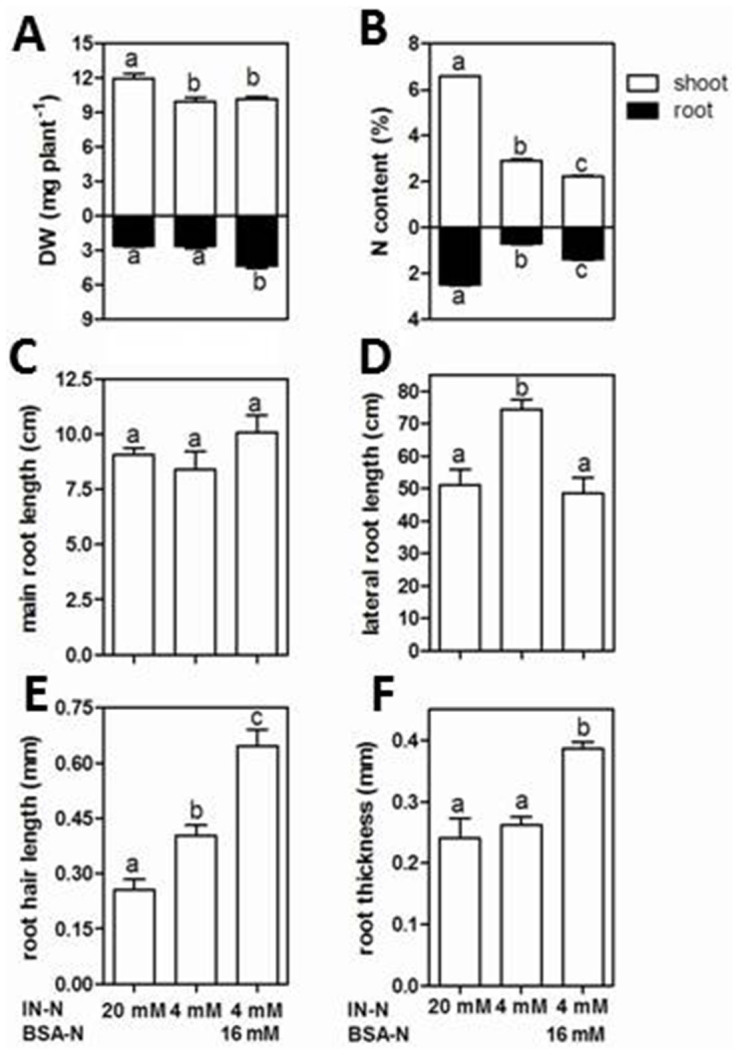
Bars of (A–B) represent average ± SEM of 5 plates each with 4 Arabidopsis plants. Bars represent average ± SEM of 10 roots hairs on 3 plants (E) or 3–10 plants (C,D,F). Different letters in each panel indicate significant differences at P < 0.05 (ANOVA, Neuman–Keuls post hoc test).
BSA acts independently to auxin and ethylene
A network of hormones is involved in root physiological responses29. Auxin has a central role in controlling root architecture30 with potential to be involved in the effects associated with BSA including a higher primary root length (early stage of seedling growth, Figure 3), higher lateral root initiation (later stage of seedling growth, Figure 3) and root hair elongation (Figure 2). Ethylene has been reported to promote root hair elongation31. We investigated the possibility that physiological effect of BSA occur through alteration in auxin and ethylene relations.
To test whether BSA influences auxin levels in plant roots, we compared the expression of DR5:β-glucuronidase (GUS) auxin-responsive reporter gene in Arabidopsis grown in medium containing replete concentration of N (20 mM) without or with BSA (5 and 45 μM BSA), or with synthetic auxin 1-naphthalene acetic acid (1-NAA). Plants grown in presence of 1-NAA showed prominent blue coloration in roots, demonstrating the effectiveness of the DR5-GUS reporter system (Figure 6D). No significant differences in auxin levels occurred in plants grown with BSA and IN controls (Figure 6). To further evaluate this observation, we studied the response of BSA in the Transport Inhibitor Response1 (tir1-1) Arabidopsis mutant which is altered in its response to auxin and characterized by reduced root branching compared to wild type32. As expected, mutants had a lower number of lateral roots compared to wild type with IN supply (P < 0.05, Fig. 7). Roots of the tir1-1 mutant and wild type seedlings had a similar morphology in the presence of BSA with fewer numbers of a lateral roots at the early stage of growth (7 d) but an equivalent number at 14 days of growth (Fig. 7).
Figure 6. Expression of auxin-responsive DR5:GUS in 7-d-old Arabidopsis seedling.
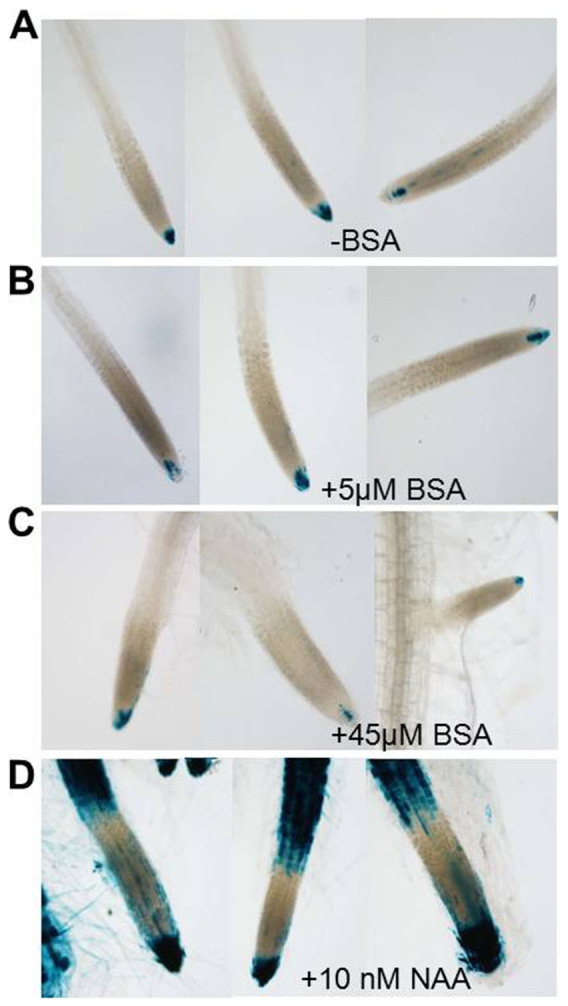
Seedlings were removed from agar plates and histochemically stained for GUS. Arabidopsis was grown on nitrogen replete medium (10 mM NH4NO3), without BSA (A), with 5 μM BSA (B), with 45 μM BSA (C), or with 10 nM 1-NAA (D).
Figure 7. Root growth of the Arabidopsis wild type and Transport Inhibitor Response1 (tir1_1) mutant plants in response to BSA.
(A) 14-day-old tir11 mutant exhibited root morphology changes in response to BSA similar to wild type. (B) In the early growth stage (7 d), the number of lateral root of wild type and tir11 mutant was lower in BSA treatment, whereas no difference was observed after 14 d. Different letters indicate significant differences at P < 0.05. Error bars indicate SEM.
The Auxin Resistance 2 (axr2-1) mutant has decreased primary root length33. Our results showed that BSA triggered primary root elongation in the early stage of growth (Figure 3A). We tested whether axr2-1 displays a different phenotype but both, wild type and axr2-1 mutant, had similar root morphologies with shorter primary roots in the absence of BSA (P < 0.001, Fig. 8A).
Figure 8. Effect of BSA on Arabidopsis wild type, axr2-1 mutant, and ein2-1 mutant.
(A) The effect of BSA on the primary root length of axr2-1 mutant is similar to wild type, with BSA triggering primary root elongation at an early stage of growth (7 d). (B) Similar to wild type, BSA triggers root hair elongation of axr2-1 and ein2-1 mutants at later stage of growth (14 d). Different letters indicate significant differences at P < 0.05. Error bars indicate SEM.
The axr2-1 mutant is also defective in root hair elongation33, similar to ethylene-insensitive2 (ein2-1) mutant31 and we studied their responses to BSA. As expected, compared to wild type, mutants had shorter root hairs in the absence of BSA (P < 0.001 for axr2-1 and P < 0.05 for ein2-1), but in the presence of BSA root hair elongation was similarly stimulated in mutants and wild type (Fig. 8B).
Discussion
Here we quantified the responses of Arabidopsis to the presence of high molecular mass ON. We show that protein in the form of BSA affects plant morphology in a manner distinct from that observed with IN. With IN-replete growth medium as control, we demonstrate that the effect of BSA on root morphology is not directly caused by its potential role as nutrient source, but that BSA elicits specific responses independent of N supply. This is in agreement with the notion that roots exhibit measurable responses to organic nutrients irrespective of the plants' nutritional status21. In a concentration dependent manner, BSA (i) alters biomass partitioning by increasing root growth but not affecting shoot growth, (ii) modifies root architecture by delaying lateral root initiation, (iii) increases root thickness, and (iv) promotes the elongation of root hairs.
The observation that the presence of BSA favours root growth, but not at the cost of shoot growth is consistent with observations that ON can increase the root-to-shoot ratio34. Similarly, herbaceous species supplied with glutamine as N source have proportionally more roots than plants supplied with IN21,24, and conifer seedlings have higher root-to-shoot ratios when supplied with arginine than IN22. These examples are congruent with the concept that organic compounds stimulate root proliferation which may assist the exploitation of organic matter rich sites within the soil matrix. BSA also triggered a shift towards growth of the lower part of the primary root by promoting primary root elongation in the early stage of seedling growth in combination with delayed lateral root initiation. It remains to be investigated if this response occurs in soils and if so, how it would assist the acquisition of ON from biogenic materials.
At low to medium concentrations, BSA promoted root growth, increased root thickness and root hair length. A network of hormones is involved in root physiological responses35, which may drive the documented effects of amino acids on root morphology. For example, reduction of L-glutamate sensitivity in an auxin-transport mutant (aux1-7) suggests a possible interaction between L-glutamate and auxin signalling36. The expression of genes for signal transduction and transcription regulation of auxin transport, ethylene synthesis, and cyclin-dependent kinases may be responsible for stimulated lateral root growth in the presence of nitrate37. However, we found that the effects of BSA on root morphology appear to be independent from auxin and ethylene signalling pathways. It is further verified by the fact that BSA triggered an increase up to 10 cells in the single cortical and endodermal layer in primary roots (Fig. 2G), whereas in Arabidopsis, the number of 8 cells has been reported to be invariant38 and to our knowledge, unaltered by phytohormones. This implies the existence of a new pathway independent of phytohormones.
While sensing mechanisms for IN and amino acids have been described, including dual function transporter and receptor proteins (‘transceptors')6,7,10,26,39, sensing pathways of ON polymers by roots are largely unknown. The mechanisms involved in sensing and responding to organic polymers with nutrient function require further investigation to understand their role for plant function as plant nutrition systems shift to a broader range of supply systems that encompass organic compounds reviewed by34.
At high concentrations, BSA inhibited root development, similar to the effects of IN e.g.40, glutamate (>50 μM), glycine (10 mM N), serine and valine (3 mM N)24,36,41. We cannot exclude the possibility that the root growth inhibition observed here with high concentration of BSA is caused by the release of amino acids by proteolytic activity of roots. But it seems unlikely that depolymerisation of BSA causes the extreme amino acid imbalances that are generated by single-amino acid experiments.
Our observations have to be evaluated with additional protein sources as changes in root morphology could be an effect of the specific amino acid sequence and structure of BSA. BSA was used here and in a previous study28 because it is of a size representative of soil proteins and an easily available protein that is widely used in biological studies. In addition to being a N source that is less accessible than IN and low molecular mass ON, BSA may interfere with the availability and uptake of other nutrients, and indirectly cause changes in root morphology as seen with a range of nutrient deficiencies42. Testing a broader range of proteins in context of different nutrient supply systems would be next steps.
Independent of concentration, BSA increased roots thickness. We showed that roots access proteins by exuding proteolytic enzymes and incorporating protein28. We currently cannot link the effect on root thickness to a specific form of ON (i.e. intact protein or proteolysis products), but it appears to be a novel characteristic that has not been described before in the context of organic nutrients. The function of this morphological change has to be evaluated further in context of a range of externally supplied proteins and in the presence of microbes. In summary, findings here add to understanding on how different forms of ON influence root growth and function. Our study highlights the need to evaluate plant responses in the presence of both IN and ON to more closely resemble soil conditions to expand existing knowledge that has been generated in IN or single N source test systems.
Methods
Plant material and growth conditions
Wild type or mutant Arabidopsis (Arabidopsis thaliana ecotype Columbia [Col-0]) were used in this study. Surface-sterilized seeds were grown in Petri dishes containing 30 ml of one-half-strength Murashige and Skoog medium43 (MS Basal medium [M5519], Sigma-Aldrich, Australia, experiment 1) or N-free MS medium (MS Basal Salt Solution [M0529:Sigma-Aldrich, Australia], supplemented with MS vitamin, 3 mM CaCl2, 1.5 mM MgSO4, 1.25 mM KH2PO4, experiment 2). The media were supplemented with 1% sucrose and adjusted to pH 5.5 and 0.3% phytagel (Phytotechnologies, Kansas, USA) was used as solidifying substance. Nitrogen was added as protein (bovine serum albumen, ≥98% purity BSA, Sigma-Aldrich,) or IN (ammonium-nitrate), or combinations of BSA and IN (Table 1). To eliminate contaminations with low molecular mass compounds, BSA was solubilized in sterile distilled water and dialyzed as described in28.
Plated seeds were incubated at 4°C in the dark for three days and then transferred to a growth cabinet (21°C, 16 h/8 h day/night, 150 μmol m−2 s−1) and grown in a vertical position. The length of 10 randomly selected root hairs was measured in three 2 mm segments at ~2 mm distance from the main root axis. Primary root length and lateral root lengths of five plants were measured using the WinRhizo™ 2007 program (Reagent Instruments Inc., Canada). For N content analysis, plants were rinsed and cleaned three times in 0.5 mM CaCl2 to remove N from plant surfaces. Plants were dried at 60°C for 2 days, weighed, homogenized and analyzed with a LECO TruSpec CHN analyser (LECO Corporation, MI). Results represent averages and SEM of 3 plates with 4 Arabidopsis plants per plate. All growth experiments were repeated 2 or 3-times.
GUS staining
GUS staining was carried out as previously described44. Seedlings were placed in GUS solution for 24 h at 37°C and cleared in 50% ethanol.
Microscopy
Root sections, root hairs, and root thickness were analyzed with a confocal laser scanning microscope (CLSM, Zeiss LSM510 META, Carl Zeiss, Germany) or a compound microscope (Nikon Eclipse E600, Japan). For root sections the middle sections of primary roots (~1.5 cm long), approximately 2 cm from the root tip, were embedded in 3% agarose prior to vibratome cutting (Leica VT 1200S, Leica, Germany). CLSM was used to image root sections and root hairs with 10× dry, 20× water immersion objectives, 40× or 60× oil immersion objectives. Images were captured with a SPOT camera and imported into SPOT RT imaging software v3.5 (SPOT™ Diagnostic Instrument, Inc., Sterling Height, MI, USA) for the compound microscope or with a Zeiss LSM Image Browser (Carl Zeiss, Germany) for the confocal microscope.
Statistical analysis
Statistical analyses were performed using ANOVA, Neuman–Keuls post hoc test (GraphPad Prism4, GraphPad Software, Inc., San Diego CA, USA).
Author Contributions
T.G.A.L., D.R., T.N., S.S. and C.P.-L. wrote the main manuscript text and T.G.A.L., Y.T., A.Y. and C.P.-L. performed the experiments. All authors reviewed the manuscript.
Acknowledgments
We are grateful to Dr Philip Brewer for providing auxin response mutants and DR5:GUS line. Thanks to the ARC Centre of Excellence for Integrative Legume Research access to research facilities. This research was supported by Australian Research Council Discovery Grant DP0986495 (to S.S., D.R., T.N.).
References
- Ericsson T. Growth and shoot: Root ratio of seedlings in relation to nutrient availability. Plant Soil 168, 205–214 (1995). [Google Scholar]
- Okajima H. Plant Nutrient Acquisition - New Perspectives [Ae N., Arihara J., Okada K., & Srinivasan A. (eds.) [3–31] (Springer, Japan 2001). [Google Scholar]
- Robinson D. The responses of plants to non-uniform supplies of nutrients. New Phytol. 127, 635–674 (1994). [DOI] [PubMed] [Google Scholar]
- Hodge A. Root decisions. Plant Cell Environ. 32, 628–640 (2009). [DOI] [PubMed] [Google Scholar]
- Robinson D. & Rorison I. H. Root hairs and plant growth at low nitrogen availabilities. New Phytol. 107, 681–693 (1987). [Google Scholar]
- Forde B. G. & Walch-Liu P. Nitrate and glutamate as environmental cues for behavioural responses in plant roots. Plant Cell Environ. 32, 682–693 (2009). [DOI] [PubMed] [Google Scholar]
- Lima J. E., Kojima S., Takahashi H. & von Wiren N. Ammonium triggers lateral root branching in Arabidopsis in an AMMONIUM TRANSPORTER1;3-dependent manner. Plant Cell 22, 3621–3633 (2010). [DOI] [PMC free article] [PubMed] [Google Scholar]
- Gojon A., Nacry P. & Davidian J.-C. Root uptake regulation: a central process for NPS homeostasis in plants. Curr. Opin. Plant Biol. 12, 328–338 (2009). [DOI] [PubMed] [Google Scholar]
- Drew M. C. Comparison of the effects of a localized supply of phosphate, nitrate, ammonium and potassium on the growth of the seminal root system, and the shoot, in barley. New Phytol. 75, 479–490 (1975). [Google Scholar]
- Zhang H. M., Jennings A., Barlow P. W. & Forde B. G. Dual pathways for regulation of root branching by nitrate. Proc. Natl. Acad. Sci. U. S. A. 96, 6529–6534 (1999). [DOI] [PMC free article] [PubMed] [Google Scholar]
- Hermans C., Hammond J. P., White P. J. & Verbruggen N. How do plants respond to nutrient shortage by biomass allocation? Trends Plant Sci. 11, 610–617 (2006). [DOI] [PubMed] [Google Scholar]
- Wolt J. D. Soil Solution Chemistry: Applications to Environmental Science and Agriculture. (Wiley& Sons, Inc., 1994). [Google Scholar]
- Schulten H. R. & Schnitzer M. The chemistry of soil organic nitrogen: a review. Biol. Fertil. Soils 26, 1–15 (1997). [Google Scholar]
- Schulze W. X. Protein analysis in dissolved organic matter: What proteins from organic debris, soil leachate and surface water can tell us - a perspective. Biogeosciences 2, 75–86 (2005). [Google Scholar]
- Jones D. L. et al. Soil organic nitrogen mineralization across a global latitudinal gradient. Global Biogeochem Cy 23, 1–5 (2009). [Google Scholar]
- Lipson D. & Näsholm T. The unexpected versatility of plants: organic nitrogen use and availability in terrestrial ecosystems. Oecologia 128, 305–316 (2001). [DOI] [PubMed] [Google Scholar]
- Jämtgård S., Näsholm T. & Huss-Danell K. Nitrogen compounds in soil solutions of agricultural land. Soil Biol. Biochem. 42, 2325–2330 (2010). [Google Scholar]
- Holst J., Brackin R., Robinson N., Lakshmanan P. & Schmidt S. Soluble inorganic and organic nitrogen in two Australian soils under sugarcane cultivation. Agric. Ecosyst. Environ. 155, 16–26 (2012). [Google Scholar]
- Hill P. W. et al. Acquisition and assimilation of nitrogen as peptide-bound and D-enantiomers of amino acids by wheat. PLoS ONE 6, e19220 (2011). [DOI] [PMC free article] [PubMed] [Google Scholar]
- Hutchinson H. & Miller N. The direct assimilation of inorganic and organic forms of nitrogen by higher plants. Centralblatt für Bakt 30, 513–547 (1911). [Google Scholar]
- Cambui C. A. et al. Patterns of plant biomass partitioning depend on nitrogen source. PLoS ONE 6, e19211 (2011). [DOI] [PMC free article] [PubMed] [Google Scholar]
- Gruffman L., Ishida T., Nordin A. & Nasholm T. Cultivation of Norway spruce and Scots pine on organic nitrogen improves seedling morphology and field performance. For. Ecol. Manag. 276, 118–124 (2012). [Google Scholar]
- Matsubayashi Y. & Sakagami Y. Phytosulfokine, sulfated peptides that induce the proliferation of single mesophyll cells of Asparagus officinalis L. Proc. Natl. Acad. Sci. U. S. A. 93, 7623–7627 (1996). [DOI] [PMC free article] [PubMed] [Google Scholar]
- Soper F. M. et al. Arabidopsis and Lobelia anceps access small peptides as a nitrogen source for growth. Funct. Plant Biol. 38, 788–796 (2011). [DOI] [PubMed] [Google Scholar]
- Vinall K., Schmidt S., Brackin R., Lakshmanan P. & Robinson N. Amino acids are a nitrogen source for sugarcane. Funct. Plant Biol. 39, 503–511 (2012). [DOI] [PubMed] [Google Scholar]
- Walch-Liu P. et al. Nitrogen regulation of root branching. Ann. Bot. (Lond.) 97, 875–881 (2006). [DOI] [PMC free article] [PubMed] [Google Scholar]
- Yamakawa S. et al. The promotive effects of a peptidyl plant growth factor, phytosulfokine-alpha, on the formation of adventitious roots and expression of a gene for a root-specific cystatin in cucumber hypocotyls. J. Plant Res. 111, 453–458 (1998). [Google Scholar]
- Paungfoo-Lonhienne C. et al. Plants can use protein as a nitrogen source without assistance from other organisms. Proc. Natl. Acad. Sci. U. S. A. 105, 4524–4529 (2008). [DOI] [PMC free article] [PubMed] [Google Scholar]
- Garay-Arroyo A., De La Paz Sánchez M., García-Ponce B., Azpeitia E. & Álvarez-Buylla E. R. Hormone symphony during root growth and development. Dev. Dyn. 241, 1867–1885 (2012). [DOI] [PubMed] [Google Scholar]
- Overvoorde P., Fukaki H. & Beeckman T. Auxin control of root development. CSH Perspectives 2, 1–16 (2010). [DOI] [PMC free article] [PubMed] [Google Scholar]
- Pitts R., Cernac A. & Estelle M. Auxin and ethylene promote root hair elongation in Arabidopsis. Plant J 16, 553–560 (1998). [DOI] [PubMed] [Google Scholar]
- Parry G. et al. Complex regulation of the TIR1/AFB family of auxin receptors. Proc. Natl. Acad. Sci. U. S. A. 106, 22540–22545 (2009). [DOI] [PMC free article] [PubMed] [Google Scholar]
- Wilson A., Pickett F. B., Turner J. & Estelle M. A dominant mutation in Arabidopsis confers resistance to auxin, ethylene and abscisic acid. Mol. Gen. Genet. 222, 377–383 (1990). [DOI] [PubMed] [Google Scholar]
- Paungfoo-Lonhienne C., Visser J., Lonhienne T. G. A. & Schmidt S. Past, present and future of organic nutrients. Plant Soil 359, 1–18 (2012). [Google Scholar]
- Fukaki H. & Tasaka M. Hormone interactions during lateral root formation. Plant Mol. Biol. 69, 437–449 (2009). [DOI] [PubMed] [Google Scholar]
- Walch-Liu P., Liu L. H., Remans T., Tester M. & Forde B. G. Evidence that L-glutamate can act as an exogenous signal to modulate root growth and branching in Arabidopsis thaliana. Plant Cell Physiol. 47, 1045–1057 (2006). [DOI] [PubMed] [Google Scholar]
- Wang X. et al. Identification of genes enriched in rice roots of the local nitrate treatment and their expression patterns in split-root treatment. Gene 297, 93–102 (2002). [DOI] [PubMed] [Google Scholar]
- Dolan L. et al. Cellular organisation of the Arabidopsis thaliana root. Development 119, 71–84 (1993). [DOI] [PubMed] [Google Scholar]
- Tsay Y. F., Chiu C. C., Tsai C. B., Ho C. H. & Hsu P. K. Nitrate transporters and peptide transporters. FEBS Lett. 581, 2290–2300 (2007). [DOI] [PubMed] [Google Scholar]
- Rogato A. et al. Characterization of a Developmental Root Response Caused by External Ammonium Supply in Lotus japonicus. Plant Physiol. 154, 784–795 (2010). [DOI] [PMC free article] [PubMed] [Google Scholar]
- Forsum O., Svennerstam H., Ganeteg U. & Nasholm T. Capacities and constraints of amino acid utilization in Arabidopsis. New Phytol. 179, 1058–1069 (2008). [DOI] [PubMed] [Google Scholar]
- Gruber B. D., Giehl R. F. H., Friedel S. & von Wiren N. Plasticity of the Arabidopsis root system under nutrient deficiencies. Plant Physiol. 163, 161–179 (2013). [DOI] [PMC free article] [PubMed] [Google Scholar]
- Murashige T. & Skoog F. A revised medium for rapid growth and bio assays with tobacco tissue cultures. Physiol. Plant 15, 473–497 (1962). [Google Scholar]
- Hagen G., Martin G., Li Y. & Guilfoyle T. J. Auxin-induced expression of the soybean GH3 promoter in transgenic tobacco plants. Plant Mol. Biol. 17, 567–579 (1991). [DOI] [PubMed] [Google Scholar]



